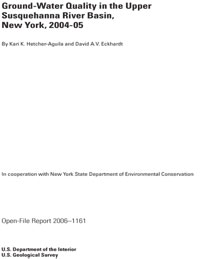 Ground-water quality in the upper Susquehanna River Basin, New York, 2004-05
Ground-water quality in the upper Susquehanna River Basin, New York, 2004-05
by Kari K. Hetcher-Aguila and David A.V. Eckhardt
U.S. GEOLOGICAL SURVEY
Open-File Report 2006-1161
ABSTRACT
Water samples were collected from 20 public-supply
wells and 13 private residential wells throughout the upper
Susquehanna River Basin (upstream from the Pennsylvania
border) during the fall of 2004 and the spring of 2005 and
analyzed to describe the chemical quality of ground water
in the upper basin. Wells were selected to represent areas
of greatest ground-water use and highest vulnerability to
contamination, and to provide a representative sampling
from the entire (4,516 square-mile) upper basin. Samples
were analyzed for physical properties, nutrients, inorganic
constituents, metals, radionuclides, pesticides, volatile organic
compounds, and bacteria.
The cations that were detected in the highest
concentrations were calcium, magnesium, and sodium; the
anions that were detected in the greatest concentrations
were bicarbonate, chloride, and sulfate. The predominant
nutrient was nitrate, the concentrations of which were greater
in samples from sand and gravel aquifers than in samples
from bedrock. The metals barium, boron, cobalt, copper, and
nickel were detected in every sample; the metals with the
highest concentrations were barium, boron, iron, manganese,
strontium, and lithium. The pesticide compounds detected
most frequently were atrazine, deethylatrazine, alachlor ESA,
and two degradation products of metolachlor (metolachlor
ESA and metolachlor OA); the compounds detected in highest
concentration were metolachlor ESA and OA. Volatile organic
compounds were detected in 11 samples, and concentrations
of 3 of these compounds exceeded 1 microgram per liter
(µg/L).
Several analytes were found in concentrations that
exceeded Federal and New York State water-quality standards,
which are typically identical. Chloride concentrations
exceeded the U.S. Environmental Protection Agency
(USEPA) Secondary Maximum Contaminant Level (SMCL)
of 250 milligrams per liter (mg/L) in two samples, and
sulfate concentrations exceeded the SMCL of 250 mg/L in
one sample. Sodium concentrations exceeded the USEPA
Drinking Water Advisory of 60mg/L in six samples. Nitrate
concentrations exceeded the USEPA Maximum Contaminant
Level (MCL) of 10 mg/L in one sample and approached this
limit (at 9.84 mg/L) in another sample. Barium concentrations
exceeded the MCL of 2,000 µg/L in one sample. Iron
concentrations exceeded the SMCL of 300 µg/L in five
samples, and manganese concentrations exceeded the SMCL
of 50 µg/L in 14 samples. Arsenic was detected in seven
samples, and the MCL for arsenic (10 µg/L) was exceeded
in two samples. Radon-222 exceeded the proposed MCL of
300 picocuries per liter in 24 samples. Any detection of total
coliform or fecal coliform bacteria is considered a violation of
New York State health regulations; in this study, total coliform
was detected in six samples; fecal coliform was detected in
one sample, and Escherichia coli was not detected in any
sample.
Citation: Hetcher-Aguila, K.K. and Eckhardt, D.A.V., 2006, Ground-water quality in the upper Susquehanna River Basin,
New York, 2004-05: U.S. Geological Survey Open-File Report 2006-1161, 20 p., online only.
 [Full Report, Acrobat PDF
(1.9M)]
[Full Report, Acrobat PDF
(1.9M)]
[an error occurred while processing this directive]
|
